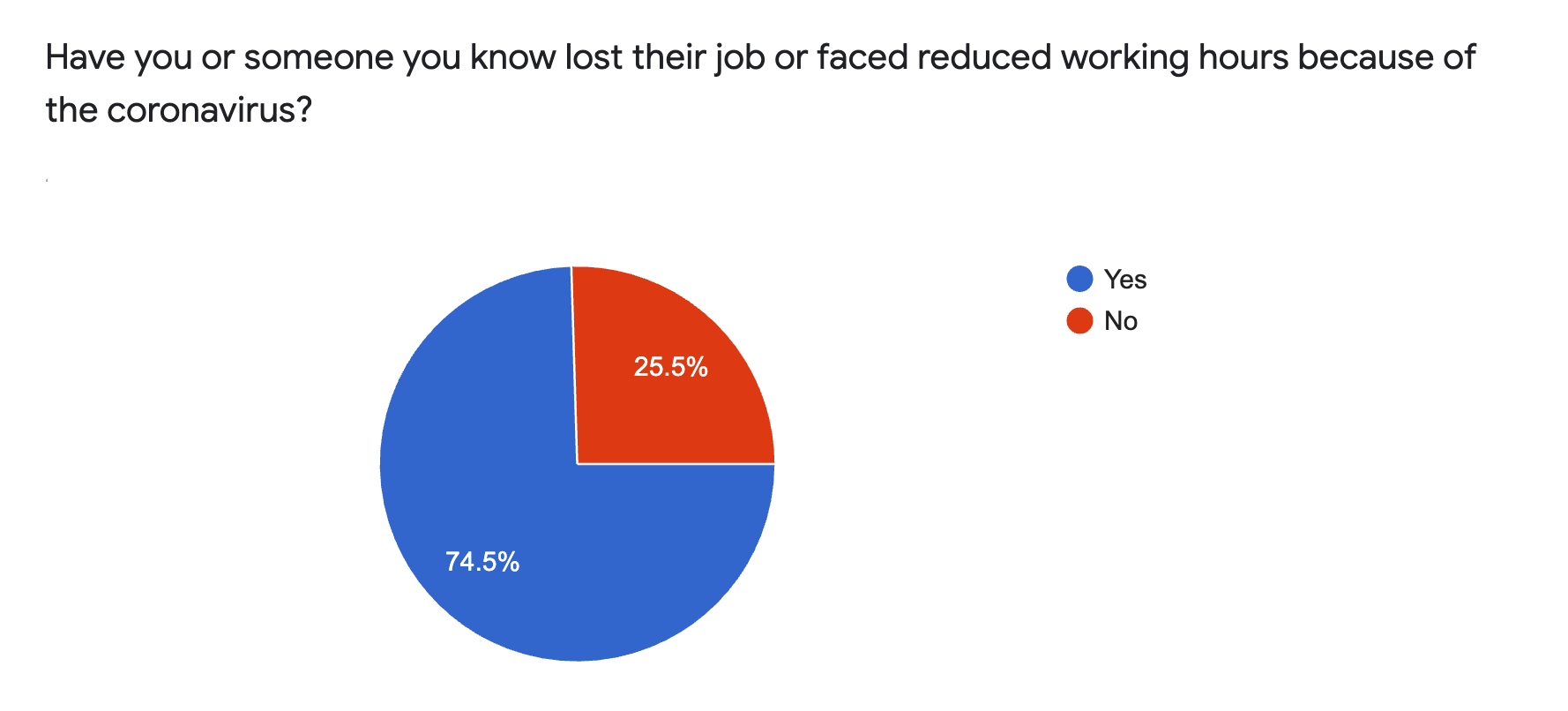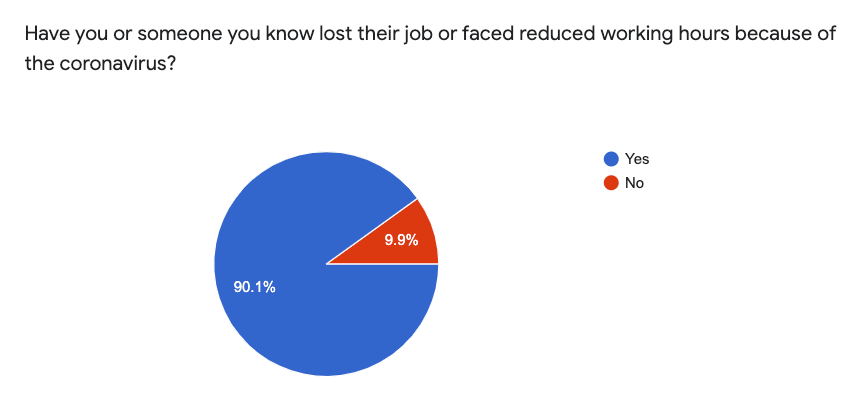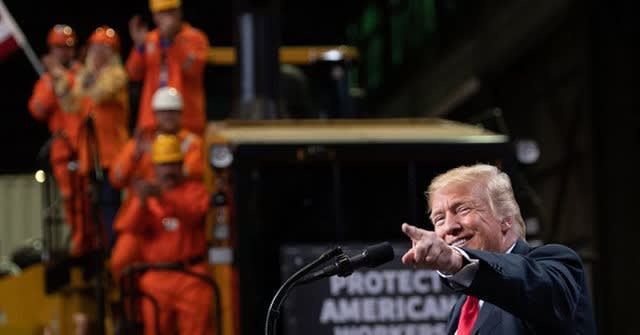Tangle is an independent, ad-free, non-partisan politics newsletter that offers both sides of the biggest news stories every day. If you found this online or someone forwarded you this email, please consider supporting balanced, independent journalism by subscribing for free below:
Today’s read: 5 minutes.
Tangle is a Monday-Thursday newsletter, with occasional Friday editions. I just wanted to send out a quick update and answer a few questions in today’s newsletter.
Thank you.
To everyone who filled out yesterday’s poll. If you haven’t done it yet, you can click the button below to respond.
This was the most responses I’ve ever gotten on a Tangle poll and, so far, they are super interesting. I will be sharing some of the numbers and insights when the newsletter is back next week. Here is one interesting insight:
As of March 20th, 74.5% of Tangle readers said they knew someone who had lost their job or faced reduced working hours because of the coronavirus:

So far, 90.1% of respondents to yesterday’s poll have said they know someone who lost their job or faced reduced working hours because of coronavirus.

Reader mailbag.
One of my favorite parts about Tangle is answering reader questions. It’s part of the ethos of the newsletter, which is that I want readers to drive the direction it goes. If you want to ask a question, all you have to do is reply to this email. I have gotten a ton of great questions in the last week and just wanted to tackle a few in one newsletter to make sure they didn’t get lost in the shuffle.
Q: Thought about something that could be interesting to look back on - when did Tangle first start to report on the coronavirus in response to the rest of the media world? Not pointing fingers and obviously you hit on major stuff day-to-day, but would be interesting to see when it popped on the newsletter.
- Dan, San Francisco, CA
Tangle: This was actually a really fun exercise and I’m disappointed I didn’t go back and do this on my own. The first mention of coronavirus in Tangle was on January 27th, and it was in my “Numbers” section. I shared the following statistics but had no other comment on it:
- 2,744. The number of reported cases of coronavirus, the deadly infection spreading across the globe.
- 81. The death toll from coronavirus.
- 13. The number of countries with reported cases of coronavirus outside China and Hong Kong, where it originated.
- 5. The number of confirmed cases in the United States, according to the CDC.
The second mention came on January 29th, and was a little embarrassing to read. I wrote that the virus has killed 132 people in China already but then added a “bit of perspective: Remember that this year’s flu season has already killed 8,200 people with 15 million cases in America alone.” That part made me flush. However, I did include it at the top, so it was a featured part of the newsletter, and I said that if you were worried about the virus that you should check out a CDC resource a reader from Washington sent in. That resource was extremely strong and informative and the information there has mostly aged well.
I only mentioned the virus again in the “Numbers section” for the next couple of weeks. The third mention from Tangle came on February 18th. This was in response to a reader question from Eric in Norfolk, Virginia. He wrote in and said this:
I know it’s not political, but I’m surprised that you haven’t really covered the coronavirus at all. What do you make of it? Any thoughts on how it will impact the U.S.?
My response to Eric was equal parts bad and good. I started out by saying that I had been trying to “avoid the hysteria around this story for weeks, but things are becoming a bit too tangible to ignore.” That sentence hasn’t really aged well. It implies that a) people were already hysterical about it and b) I was ignoring some of the hysteria that now could probably be described as reasonable warning signs something really bad was coming. In my defense, I’ll say that we knew so little then publicly that I didn’t have enough of an informed or confident opinion to share news about it. Remember: this was around the time the president and senators were getting private briefings that as many as 200,000 people could die (and some were off selling their stock portfolios predicting a huge market crash). The public mostly just had piecemeal info from China about the virus’s spread.
Other parts of my response that didn’t age well: I called Sen. Tom Cotton’s proposition that the virus may have started in a Wuhan lab a “conspiracy theory.” There is actually reporting that came out today to suggest it may still be possible. At the time, I was working on the information we had, and it’s possible Cotton was privy to information I didn’t have. I also had this whopper of a paragraph:
“On the other hand, things like the flu still seem far more dangerous (on the numbers alone) and kill far more people annually than the coronavirus will. The threat, excitement and fear over this largely have to do with the unknown nature of it. Which I get. But there is still a part of me that feels it’s being a bit overblown.”
The parts that did age well were how I framed the virus’s danger. I noted that we knew very little, that cities larger than New York were shutting down and that Apple was already sending signals this could send the stock market into a spiral. I wrote that we knew human-to-human contact was spreading the virus and we knew doctors on the front lines in China were dying, which indicated to me this was extremely contagious and much more deadly than your average virus. I also wrote how the virus was being “swept under the rug” by officials in China and the United States and is “certainly worse than we initially thought.” I also asked for readers from China to chime in with their own stories and prepared myself for this moment by finishing with this line:
Either way, I’m sure things could continue to develop in a way that makes me want to eat my words and delete this post from the internet. But it’s a situation I’m keeping an eye on — and definitely one that could further impact the U.S. economy and U.S.-China relations. I also know I have some readers from China and readers who are experts on China, so I’d be thrilled to hear your thoughts and include them in an upcoming newsletter!
You can read my full response here.
After this mention, my coverage mostly shaped up in mid-February and the story became a central part of the newsletter. It was being written about a lot and I think the ways I framed it in the subsequent editions has held up pretty well, especially the first full coronavirus-focused issue on February 27th titled: Coronavirus: Is it time to worry? I was already walking back the flu comparisons by then and sounding the alarm that this was really, really bad. Overall, I’d give my coverage a C or C+. I definitely would go back and make some big changes to it if I could, but I also was operating on the best public information we had from members of Congress and scientists — and some of it simply wasn’t accurate.
Q: What evidence is there that China sent faulty test kits to Italy? This was reported on NPR. Furthermore, if China hid the initial spread, what else might they not be hiding? Why can't we trust China to help us at all? Are they all bad or is there a silver lining?
- Benjamin, Washington, D.C.
Tangle: The evidence for the faulty test kits is pretty straightforward: the test kits didn’t work. They gave the wrong results. Government officials in Italy and even across Europe have said the millions of test kits they received from China have been giving inaccurate results or no results at all. Slovakia’s prime minister Igor Matovic said “We have a ton and no use for them,” adding they should “just be thrown straight into the Danube.” I don’t think this was intentional on China’s part, I just think it was a case of rushed manufacturing and their attempt to stave off what they knew was coming.
As for what else they could be hiding, there’s plenty we don’t know. It’s no coincidence they expelled reporters and I absolutely think there could be a chance this was a vaccine or something that had been experimented with in a lab and somehow made its way out. Which would both justify the concerns of some Republican officials like Tom Cotton but also make some Republican officials who have been claiming this started from Chinese people eating bats look pretty stupid. Most well-reasoned people have said the same thing up until now: we don’t know how the virus started. Maybe it was the wet markets. Maybe it was a lab. Maybe it wasn’t China. We have genomic sequencing evidence it came from animals, but it’s not surefire. The Daily Caller and The Washington Post both had stories today indicating the virus may have started in a lab. I encourage you to read them.
Is China all bad? Of course not. No country is all bad. There is a reason they are a top trading partner with America and there is a reason there are so many Chinese people living in America and Americans living in China. Simply put, our countries have great synergy. Even the Chinese government was on a mission to have a “peaceful” global rise to power over the last 30 years. Whether they did or didn’t is a hot topic of contention between historians, but I’m not going to sit here and pretend like “America is great and China is bad.” If you’ve gotten the sense I feel that way from my writing I apologize. My beef with China is mostly with President Xi, who only came into power seven years ago, and — in my opinion — is taking the country into a dangerous place. Mass spying, global aggression, trade wars, crushing dissent in every corner, etc. China has a beautiful history, culture, and a populace that has produced some of the world’s best technology and scientific achievements I can think of. But the current COVID-19 situation illustrates the way an oppressive government can put the rest of the world at risk. As I’ve said, it’s really important to distinguish between the government and the people.
Q: What do you think the future after this is like? Who are the biggest losers? Who are the biggest winners? What will never be the same, and what will always be the same?
- Reed, Pittsburgh, PA
Tangle: I love this question. I’m going to throw some things at the wall real quick and then I’m going to link you to the coolest story I saw about this.
I think coronavirus is going to lead a boom in remote work. Most bosses and companies are figuring out that they don’t need their employees to be in the office to succeed right now, and offices cost a lot of money. Start-ups especially are constantly looking for ways to cut cost, and I think the Zoom-boom is going to make people realize video chatting is almost just as effective as in-person meetings (even if Zoom is spying on you). I imagine many companies won’t ever return to the offices they are now paying to be empty. That being said, there are some studies that indicate in-person collaboration is more productive and more creative, so we may go that route only to course-correct a few years down the road.
Hugging and kissing and shaking hands with the elderly may be a thing of the past. I think this virus spread is going to bring a lot of extra caution to people — especially the at-risk population — and make everyone more aware of how germs are spread. Germophobes are going to look cool and forward-thinking instead of nerdy and weak. Supermarkets and delivery services are going to go from branding themselves “green” to branding themselves “clean.” We are going to have a lot more vaccines and ventilators and masks and gloves in storage across the U.S. for a long time.
Remote voting might get some love, too. I have no idea how Democrats are going to handle the rest of the primary season, and frankly, I have no idea how the country is going to handle voting next fall. But states and localities are already moving to make voting remotely more easily. That, for now, means voting by mail. But I imagine online voting or some kind of process for casting a ballot without signing and sealing a hard copy envelope is going to come a lot quicker than we thought a few months ago. With any luck, it means voting will be more accessible.
Movie theaters may start releasing stuff to the streaming services when they see how many people watch these next few weeks, it will (hopefully) become trendy and cool to trust experts again, and nurses and doctors will be (hopefully) revered like soldiers are for the hell they are about to go through the next few months. Restaurants could also start springing up delivery-only shops, which was a thing before and will certainly be a thing now.
I imagine sports will mostly stay the same and traveling will ultimately go back to normal, even after airlines get crushed, but it’s hard to imagine any part of the world being untouched. Now, for the article!
Politico interviewed a bunch of experts on how their fields will change going forward. I’ve only read parts of it but it’s fascinating and exactly what you’re looking for. You can read it here.
Reminder.
This is a special edition to get some reader questions answered and clear the backlog. There is no numbers, story that matters or right vs. left section today. The newsletter will be back in earnest on Monday. And don’t forget to share if you care.



Member comments